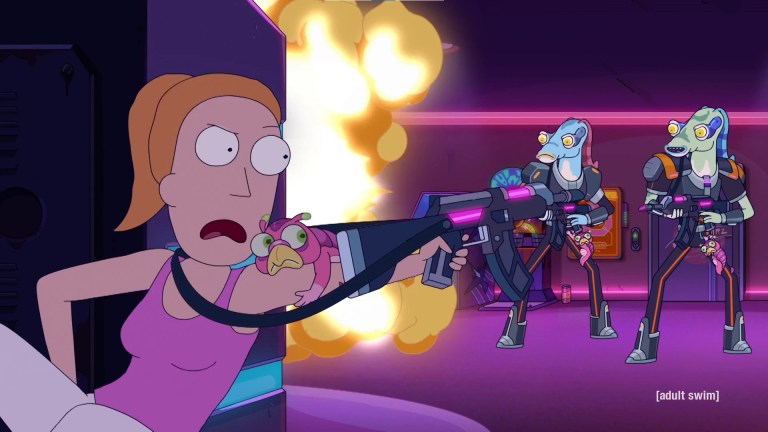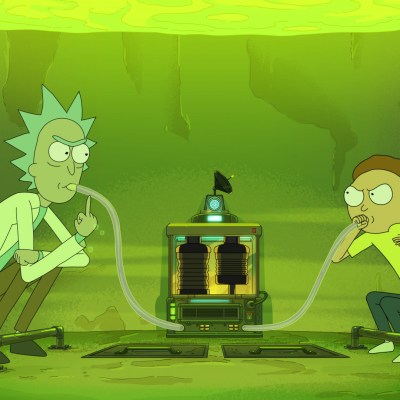Rick and Morty Season 6 Episode 2 Review: Rick: A Mort Well Lived
It Rick and Morty at its most Rick and Morty! And Dan Harmon at his most Die Hard.

This RICK AND MORTY review contains spoilers.
Rick and Morty Season 6 Episode 2
In the season premiere, we were told Rick’s portal gun was still nonfunctional and learned that Rick Prime is out there and is probably going to try to kill Rick, Morty, and, I don’t know, everybody else? The guy just seems to like killing. Recent comments from the show’s creators suggest that we can expect to see this plotline continued this season, but you can’t lore all the time, so the second episode of season six returns to more familiar territory with a quintessential Rick and Morty one-off sci-fi adventure.
“Rick: A Mort Well Lived” is quintessential in that it does that standard Rick and Morty thing of taking a sci-fi concept and then devoting an entire episode to expanding upon it—pulling it apart, exploring the inner-workings of it, and, ideally, imbuing it with emotional stakes in the process. Some examples of other episodes that do this sort of thing are “Promortyus,” which explores (and subsequently massacres) a society of face-hugger aliens; “Mort Dinner Rick Andre,” which follows the accelerated timeline of a Narnia-style dimension; and “Auto Erotic Assimilation,” which examines a society in which everyone is mind-controlled by one entity. In fact, that last one isn’t so dissimilar from this new episode, except this one’s about a society where every person is inhabited by a small piece of Morty’s consciousness.
It’s technically not totally accurate to have said this episode is without lore because it’s centered almost entirely around one of the best-ever Rick and Morty gags, the arcade game “Roy: A Life Well Lived,” introduced in season two’s “Mortynight Run.” It’s just not very deep or exciting lore, unless you’ve been waiting four seasons for more details on how the “Roy: A Life Well Lived” arcade cabinet works. It seems if you’re jacked into the game and the power goes out, the game will restart and splinter your consciousness across all the non-player characters, which is exactly what has happened to Morty. Rick has inserted himself into the game as the titular character Roy, to try and liberate Morty’s mind from the game.
A lot of clever stuff is done with this concept. Since Morty’s consciousness is being dominated by the identities of the many NPCs for whom the game world is reality, their inclination, upon hearing Rick/Roy’s message that they are all part of the same grandson, is to form a religion around this idea, which they celebrate with bad rock songs, just like Christianity does. Also, time is accelerated inside the “Roy: A Life Well Lived” game world (which, come to think of it, makes “Rick: A Mort Well Lived” like a cross between “Auto Erotic Assimilation” and “Mort Dinner Rick Andre”), so these game characters age and even have children, which leads them to existentially question whether the spawn of a Morty-brained NPC would necessarily also be imbued with Morty’s consciousness.
Outside of the game, the Blips and Chitz video arcade has been taken over by alien terrorists and it’s up to Summer to handle it, which Rick suggests she accomplish by “doing a Die Hard.” If the concept going on inside the “Roy” arcade game feels like quintessential Rick and Morty,the concept outside the game is quintessential Dan Harmon. Die Hard is the Rick and Morty co-creator’s favorite movie and he’s paid homage to it in the iconic paintball episode from his previous sitcom, Community, as well as in this series, with “Pickle Rick.”
Luckily, Harmon seems to be aware he can’t just do Die Hard again so the plot is actually less an homage to Die Hard than it is about doing homages to Die Hard. It accomplishes this by virtue of the fact that Summer hasn’t seen Die Hard so she doesn’t know how to do a Die Hard and instead just wings it, telling the alien terrorists her name is Die Hard and repeatedly shouting “Die Hard!” as she kills them all. The subversion of the subversion at the end in which Summer learns just enough about Die Hard so that she can then do at least one Die Hard was clever enough that I added a .5 to my review score.
The problem is, just because “Rick: A Mort Well Lived” feels like quintessential Rick and Morty in terms of how it tells its stories, it doesn’t mean it’s all that effective on an emotional or comedic level. I got some chuckles here and there, mostly from Summer shouting “Die Hard!” and I also liked the sexist, southern President NPC (“Sorry, Pumpkin Tits, that dog don’t hunt”). Still, though the Summer plot fared better, I found the “Roy” plot mostly to be one of those Rick and Morty concepts that’s interesting to observe the machinations of, but that doesn’t have too many great jokes. Also, a lot of people have seen Die Hard but, just like Summer, there’s a lot of younger people who probably haven’t and I assume some of this episode won’t land as well for them. The tag at the end of the credits, for example, is a reference to the censored television broadcast of Die Hard 3, the knowledge of which at this point feels like a pretty deep cut.
As for the emotional character stuff, this episode does try to go for some of that between Morty and his grandpa, but the stakes feel kind of low because it’s hard not to assume that Rick will eventually convince Morty to not keep living inside of a video game forever. Though it doesn’t feel all that emotionally weighty, Rick is pretty darn nice to Morty in this episode, saying some very kind things to him, but, because I, like Morty, have grown suspicious of everything Rick says, I wasn’t always sure how earnest he was being. However, Rick does oblige Morty his one condition for which he’ll agree to leave the arcade game, something which felt like a fairly significant, selfless act. So, it was nice, at least, to see Rick being nice.
I would never suggest the Rick and Morty team is lazy; far from it, I feel like coming up with new, complex, meta storylines must only get more difficult the more they do them. So, it’s fine for them to do another very Rick and Morty style plot and for Dan Harmon to dig deeper into his Die Hard obsession. I also appreciate the attempt to humanize Rick some more. Overall, “Rick: A Mort Well Lived” is a solidly constructed, standard Rick and Morty episode. Hopefully, going forward, season six gets funnier, too.
